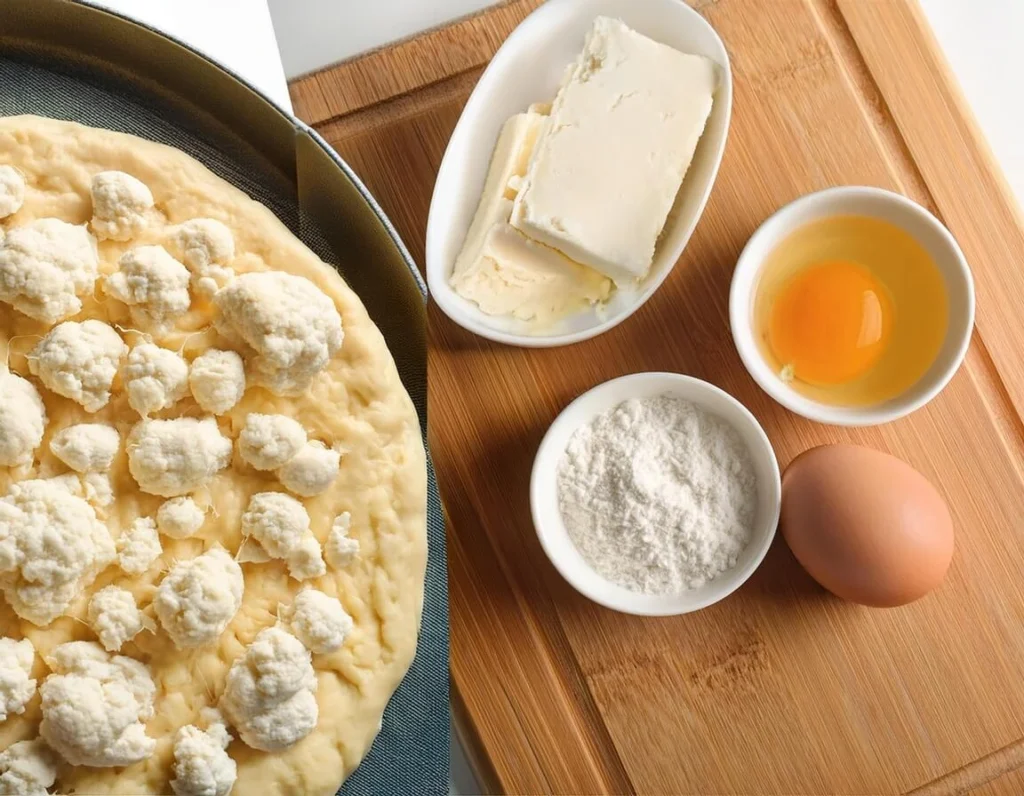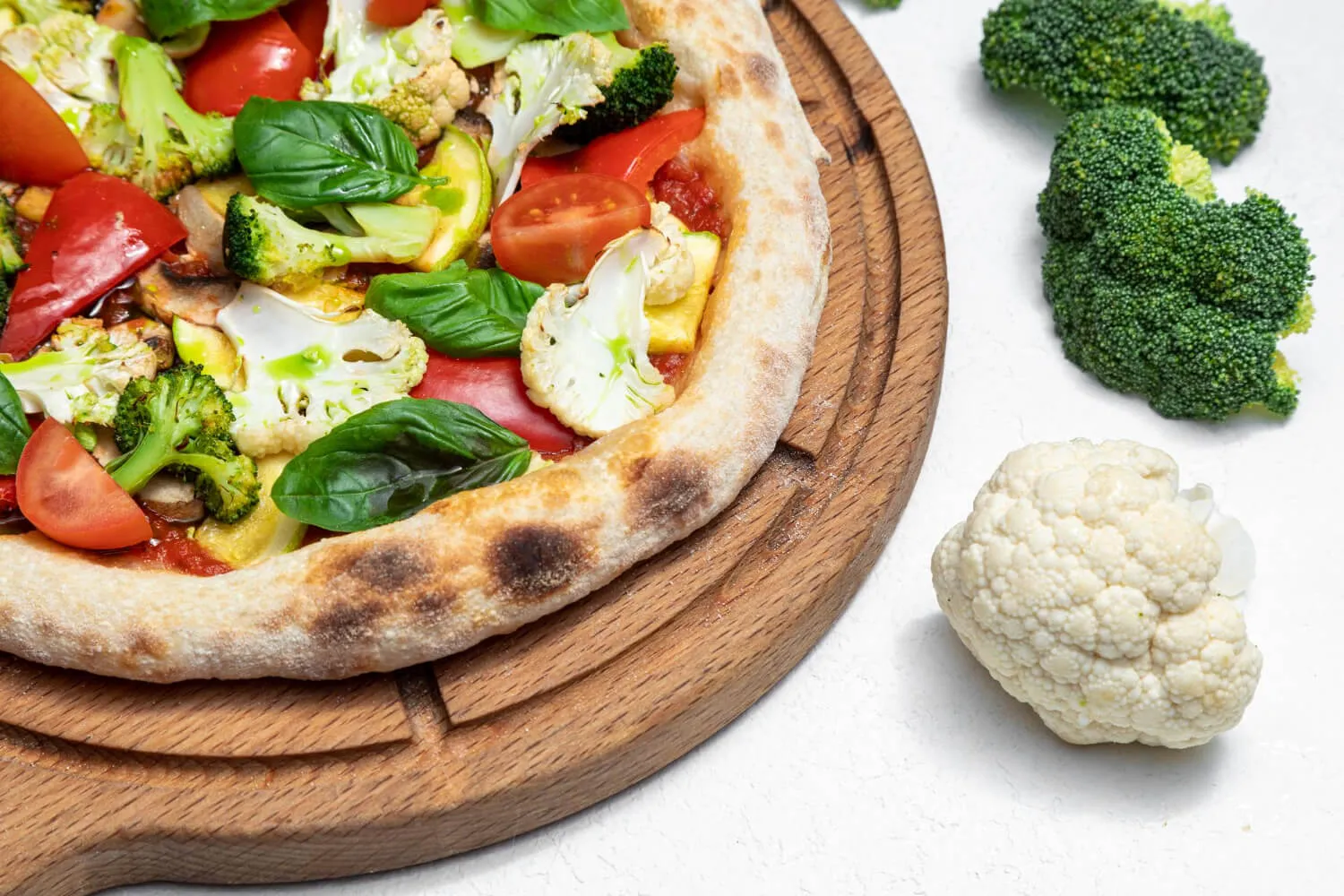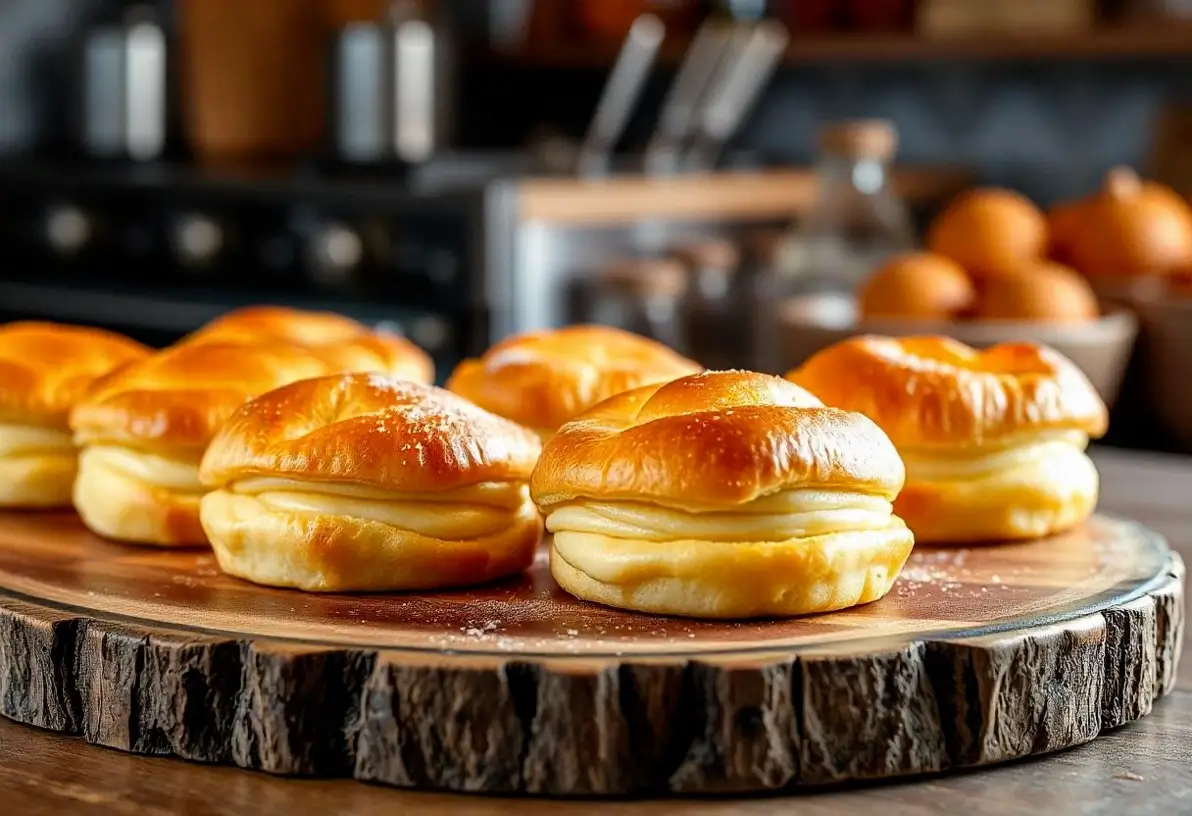Introduction
Cauliflower crust pizza has become a favorite among health-conscious consumers seeking alternatives to traditional pizza crust. Praised for being gluten-free and lower in calories, it’s often considered a top choice for those pursuing a healthier lifestyle. However, why is cauliflower crust so high in carbs? Despite its reputation, many are surprised to learn that this seemingly low-carb option can sometimes rival regular pizza crust in carbohydrate content.
So, why is cauliflower crust so high in carbs? Despite its main ingredient being a low-carb vegetable, additional ingredients like starches and flours used in most recipes can significantly increase its carbohydrate content.

In this article, we’ll explore why cauliflower crust can be unexpectedly high in carbs, compare it to traditional pizza crust, and provide insights into its nutritional profile. We’ll also share tips for making or choosing low-carb options and a simple homemade cauliflower crust recipe to suit your dietary needs.
1. What Makes Cauliflower Crust High in Carbs?
Despite being made from a low-carb vegetable, cauliflower crust pizza can still contain more carbs than expected. This is largely due to the ingredients and processing methods involved in its production.

1.1 The Ingredients Behind the Crust
The main reason for the higher carb count in cauliflower pizza crust lies in its additional ingredients. While cauliflower itself is naturally low in carbohydrates, it lacks the structure and binding properties needed to form a crust. To resolve this, manufacturers and home cooks often add ingredients such as:
- Flours: Rice flour, tapioca flour, or almond flour are commonly used to bind the crust. While almond flour is lower in carbs, rice and tapioca flours can significantly increase the overall carbohydrate content.
- Starches: Tapioca starch or potato starch are frequently added to improve texture and elasticity. These are high-carb ingredients that add to the carb count.
- Cheese and Eggs: While relatively low in carbs, these ingredients add calories and change the overall macronutrient profile, particularly in terms of fats and protein.
These additions make the crust sturdy enough to hold toppings, but they also shift the nutritional profile closer to that of regular pizza crust. In fact, when comparing carbs in cauliflower pizza crust vs. regular pizza crust, some cauliflower crusts contain only marginally fewer carbohydrates.
1.2 How Processing Affects Carb Content
Processing methods also play a role in why cauliflower crust can be high in carbs. When cauliflower is blended, steamed, or cooked, its fiber content is often reduced. Fiber, which helps slow the digestion of carbs, is an essential nutrient that can help maintain a lower glycemic index.
Commercially produced cauliflower crusts are typically more processed than homemade versions. This not only reduces their nutritional value but also makes the carbohydrates in the crust more concentrated and quickly absorbed by the body. As a result, store-bought options often have a higher glycemic impact than homemade cauliflower crusts.
Homemade cauliflower crust, on the other hand, allows for more control over the ingredients, which can help reduce the carb content while retaining fiber.
To learn more about how food processing affects fiber content and carb absorption, visit this comprehensive guide by National Library of Medicine Source.
2. Can You Eat Cauliflower Crust Pizza on a Low-Carb Diet?
Cauliflower crust pizza can be part of a low-carb diet, but not all versions are created equal. While cauliflower itself is low in carbs, the additional ingredients used in most crusts can quickly add to the carb count. Knowing how to assess and select the right options is crucial if you’re trying to stay within your daily carb limits.
Assessing Net Carbs in Store-Bought Products
When determining whether cauliflower crust fits into your low-carb diet, focus on the net carbs—the total carbohydrates minus fiber and sugar alcohols. Many store-bought cauliflower crusts contain 15–30 grams of carbs per serving, with only 1–2 grams of fiber. This makes some commercial crusts less suitable for strict low-carb diets, especially compared to homemade versions.
To ensure you’re choosing a low-carb option:
- Check the ingredient list: Look for crusts that use almond flour or flaxseed instead of rice or tapioca flour.
- Read the nutrition label: Opt for brands with fewer than 10 grams of net carbs per serving.
- Be mindful of serving sizes: The carb count is often for 1/6 or 1/8 of the crust, so consuming the entire crust may significantly exceed your carb limit.
Homemade Alternatives to Lower Carb Counts
Homemade cauliflower crust is an excellent way to control the carb content and ensure it aligns with your dietary goals. By avoiding high-carb additives like tapioca starch and rice flour, you can create a crust that’s both low in carbs and high in flavor.
For a low-carb homemade crust:
- Use riced cauliflower as the base and drain it thoroughly to remove excess moisture.
- Add almond flour, cheese, and eggs for binding without relying on starches.
- Incorporate flaxseed or psyllium husk for added fiber and texture.
So, is cauliflower crust low carb? The answer depends on how it’s made. Homemade versions are often better suited for low-carb diets, while store-bought options require careful label reading to ensure they fit your needs.
3. Is Cauliflower Pizza Crust Actually Healthy?
Cauliflower pizza crust is often praised as a healthier alternative to traditional crusts, but its health benefits depend on the ingredients and how it’s prepared. While there are definite advantages, there are also some drawbacks that consumers should consider before making it a dietary staple.
3.1 Benefits of Cauliflower Crust
1. Gluten-Free Option
For individuals with celiac disease or gluten sensitivity, cauliflower crust is an excellent alternative to wheat-based crusts. It provides the satisfaction of pizza without triggering adverse reactions.
2. Lower Calories
Compared to regular pizza crust, cauliflower crust typically contains fewer calories. This makes it appealing to those aiming to reduce their calorie intake while still enjoying pizza. For example, a single serving of cauliflower crust may range from 120–180 calories, whereas regular crust can contain 200–250 calories for the same portion.
3. Higher Nutrient Density
Cauliflower is rich in vitamins C and K, antioxidants, and dietary fiber (when minimally processed). These nutrients support immune health, bone strength, and digestion, offering more nutritional value than traditional crusts.
For calorie-conscious consumers or those looking for nutrient-dense options, cauliflower crust is a strong contender.
Cauliflower is packed with vitamins and antioxidants, as highlighted in this article on the nutritional benefits of cauliflower.
3.2 Drawbacks of Cauliflower Crust
1. Hidden Additives
Many commercial cauliflower crusts include additives like sugar, preservatives, or high-carb binding agents. These ingredients can negate some of the crust’s health benefits by increasing calories and carbohydrate content.
2. Misleading Marketing
Products marketed as “low-carb” or “healthy” may not align with those labels. For instance, when comparing the calories in cauliflower pizza crust vs. regular pizza crust, some brands include high-calorie ingredients that make the difference negligible.
3. Fiber Loss During Processing
The processing involved in creating cauliflower crust often strips away much of the vegetable’s natural fiber. Fiber is essential for digestion and helps regulate blood sugar levels. Store-bought options typically have lower fiber content compared to homemade crusts.
While cauliflower crust can be a healthy choice, reading labels and understanding the trade-offs is crucial. Opt for less processed or homemade options to maximize its benefits.
For a detailed analysis of how cauliflower crust stacks up nutritionally, read is cauliflower crust pizza healthier than regular pizza?
4. Carbs in Cauliflower Pizza Crust vs. Regular Pizza Crust
When choosing between cauliflower crust and regular pizza crust, many consumers focus on the perceived health benefits. However, the differences in carbs, calories, and fiber can vary widely depending on the brand or recipe.
4.1 Side-by-Side Comparison
Here’s a comparison of nutritional values for typical crust options per serving (approximately 1/6 of a 10-inch crust):
| Crust Type | Calories | Total Carbs (g) | Fiber (g) | Net Carbs (g) |
|---|---|---|---|---|
| Regular Crust | 180–220 | 20–30 | 1–3 | 18–29 |
| Cauliflower Crust | 120–180 | 15–30 | 1–2 | 13–28 |
| Gluten-Free Crust | 200–250 | 25–35 | 1–3 | 22–34 |
Key Takeaways:
- Cauliflower crust is often lower in calories than regular and gluten-free crusts.
- However, its carb count can be nearly as high as regular crust, particularly if it contains rice flour or starches.
- Fiber content tends to be low in all crusts unless supplemented with high-fiber ingredients.
4.2 Why Cauliflower Crust Can Be Surprisingly High in Carbs
The higher-than-expected carb content in cauliflower crust often comes from added ingredients. For comparison:
- Traditional Pizza Crust: Made from wheat flour, regular crust has a naturally high carb count due to its primary ingredient. Most of the carbs come from refined flour, which also has a higher glycemic index.
- Cauliflower-Based Crust: While cauliflower is low in carbs, most commercial or homemade recipes require additional flours (like rice or tapioca) and starches to bind the crust together. These ingredients are often comparable in carb density to wheat flour.
Additionally, commercial cauliflower crusts are sometimes marketed as low-carb even when their carb content rivals or exceeds that of regular crust. This misleading labeling can confuse consumers looking for a genuinely low-carb option.
So, why is cauliflower crust so high in carbs? The answer lies in its composition—added ingredients like flours and starches can contribute just as many carbs as traditional pizza dough, offsetting its vegetable-based benefits.
5. Which Pizza Crust Has the Least Carbs?
For those prioritizing low-carb options, cauliflower crust isn’t the only solution. Several alternatives offer even fewer carbs and cater to a variety of dietary preferences. Here’s a breakdown of the lowest-carb pizza crust options:
1. Almond Flour Crust
Almond flour crust is a favorite among those following ketogenic or gluten-free diets.
- Carb Content: ~2–4 grams of net carbs per serving (1/6 of a 10-inch crust).
- Benefits:
- High in healthy fats and low in carbohydrates.
- Packed with nutrients like vitamin E and magnesium.
- Naturally gluten-free.
Almond flour provides a rich, nutty flavor and works well for those looking to limit carbs without sacrificing taste.
2. Meat-Based Crust (Meatza)
A meat-based crust, commonly known as “meatza,” uses ground meat (such as chicken, turkey, or beef) as the base.
- Carb Content: Virtually zero carbs per serving.
- Benefits:
- High in protein and completely carb-free.
- Suitable for keto, carnivore, or paleo diets.
- Firm and sturdy enough to hold toppings without additional flours or starches.
While this option is protein-dense, it may not appeal to vegetarians or those looking for lighter meals.
3. Vegetable-Based Options (e.g., Portobello Mushrooms)
Portobello mushrooms can serve as individual pizza bases, offering a unique, low-carb alternative.
- Carb Content: ~3–5 grams of net carbs per serving (per large mushroom cap).
- Benefits:
- Extremely low in carbs while being rich in fiber and antioxidants.
- Adds a distinct umami flavor to the pizza.
- Naturally gluten-free and low-calorie.
This option is ideal for those who enjoy vegetables and are looking for a creative, portion-controlled pizza.
Comparison:
When comparing almond flour, meatza, and vegetable-based crusts, meatza has the lowest carb content, while almond flour provides a balance of low carbs and additional nutrients. Portobello mushrooms are a great choice for light, veggie-focused meals.
For the lowest-carb choice, meatza is unbeatable. However, almond flour and portobello mushroom options offer delicious variety and health benefits.
6. 10-Inch Cauliflower Pizza Crust Nutrition
A 10-inch cauliflower pizza crust is a versatile option for pizza lovers seeking a healthier alternative to traditional crusts. However, its nutritional content can vary significantly depending on the brand or recipe. Here’s a detailed breakdown of the typical nutritional values for a 10-inch cauliflower pizza crust:

Typical Nutritional Values
Per serving (approximately 1/6 of a 10-inch crust):
| Nutrient | Value |
|---|---|
| Calories | 120–180 kcal |
| Total Carbs | 15–30 grams |
| Fiber | 1–2 grams |
| Net Carbs | 13–28 grams |
| Protein | 6–10 grams |
| Fat | 5–10 grams |
These values represent averages found in commercially produced cauliflower crusts. Homemade versions may vary significantly based on the ingredients used.
For a plant-based option, consider this vegan cauliflower pizza crust recipe that’s both nutritious and delicious.
Variations and Their Impact on Nutrition
Store-Bought Crusts
Most store-bought cauliflower crusts contain additional ingredients like rice flour, tapioca starch, or potato starch, which increase the carbohydrate content. They also tend to have more preservatives and hidden sugars, leading to higher calorie and carb counts.
- Pros: Convenient and ready-to-use.
- Cons: Often higher in carbs and may contain additives.
Homemade Crusts
Homemade cauliflower pizza crust allows for greater control over ingredients, enabling you to reduce carbs and eliminate unnecessary additives.
- Pros: Can use low-carb alternatives like almond flour or flaxseed for binding.
- Cons: Requires preparation time and effort.
Key Considerations
When assessing the 10-inch cauliflower pizza crust nutrition, always check the ingredient list and nutrition label. Homemade versions tend to have a more favorable nutritional profile, especially for low-carb diets, while store-bought options are better suited for convenience.
By choosing the right recipe or brand, cauliflower crust can fit into a balanced, health-conscious meal plan.
For tips on decoding nutrition facts, explore this FDA guide on understanding nutrition labels.
7. Cauliflower Crust Pizza Recipe
Making your own cauliflower crust pizza at home allows you to control the ingredients and reduce unnecessary carbs. This simple recipe is both delicious and customizable, making it an ideal choice for those on a low-carb diet.

7.1 Ingredients
Basic Ingredients:
- 1 medium head of cauliflower (riced)
- 1 large egg
- 1/2 cup shredded mozzarella cheese
- 1/4 cup grated Parmesan cheese
- 1/2 teaspoon Italian seasoning
- 1/4 teaspoon garlic powder
- Salt to taste
Healthier Alternatives:
- Replace Parmesan cheese with almond flour for added texture and reduced carbs.
- Add flaxseed meal or psyllium husk as a fiber-rich binder to improve structure and reduce the need for starches.
7.2 Instructions
Prepare the Cauliflower
- Preheat your oven to 425°F (220°C).
- Rice the cauliflower by blending florets in a food processor or grating manually.
- Steam or microwave the riced cauliflower until tender (about 5 minutes).
- Let it cool, then squeeze out as much water as possible using a cheesecloth or clean towel. Removing excess moisture is essential for a sturdy crust.
Mix the Ingredients
- In a large mixing bowl, combine the drained cauliflower with egg, mozzarella, Parmesan, and seasonings.
- If using almond flour or flaxseed, substitute these for half the cheese or add a small amount to the mixture.
Form the Crust
- Line a baking sheet with parchment paper and lightly grease it.
- Press the cauliflower mixture into a flat, circular shape, ensuring an even thickness.
Bake the Crust
- Bake the crust in the preheated oven for 15–20 minutes, or until golden and firm.
Add Toppings and Finish
- Remove the crust from the oven, add your favorite low-carb toppings, and bake for an additional 5–10 minutes.
Tips for Reducing Carbs Further
- Use less cheese in the mixture and substitute it with almond flour or flaxseed.
- Avoid starchy binders like tapioca or potato starch.
- Stick to low-carb toppings like mozzarella, pepperoni, or fresh vegetables.
Homemade cauliflower crust pizza is not only healthier but also more customizable, allowing you to meet your dietary preferences without compromising flavor.
8. FAQ Section: Answering Common Questions
8.1 Can You Eat Cauliflower Crust Pizza on a Low-Carb Diet?
Yes, cauliflower crust pizza can fit into a low-carb diet, but it depends on the brand or recipe. Many store-bought versions contain 15–30 grams of carbs per serving, which may not align with strict low-carb goals. Homemade crusts are a better option, as you can control the ingredients and avoid high-carb additives. (See Section 2 for more insights.)
8.2 Is Cauliflower Pizza Crust Actually Healthy?
Cauliflower pizza crust has its perks—it’s gluten-free, often lower in calories, and packed with nutrients. That said, not all cauliflower crusts are created equal. Store-bought options may include additives, sugars, or high-carb binders, which can diminish its health benefits. On the other hand, homemade versions allow for healthier, more personalized ingredients.
For an in-depth analysis, including tips on choosing or making the best cauliflower crust, check out the full article here: Is Cauliflower Crust Pizza Really Healthier?
8.3 Which Pizza Crust Has the Least Carbs?
Among alternative crusts, meat-based crusts (e.g., “meatza”) have the least carbs, being virtually carb-free. Almond flour crusts and vegetable-based options like portobello mushrooms are also excellent low-carb choices, offering a balance of flavor, texture, and health benefits. (See Section 5 for a detailed comparison.)
This FAQ section highlights the key points and helps answer common questions for readers seeking clarity about cauliflower crust pizza.
Conclusion
Cauliflower crust pizza is a popular choice for those seeking a healthier alternative to traditional pizza, but it’s not always as low-carb as its reputation suggests. Why is cauliflower crust so high in carbs? The answer often lies in the additional ingredients—like rice flour, starches, and other binders—used to create its structure. These additives can significantly increase the carbohydrate content, making some cauliflower crusts comparable to regular pizza crust in terms of carbs.
To make smarter choices, always read the nutrition labels of store-bought crusts or opt for homemade recipes. By using low-carb binders like almond flour or flaxseed, you can create a healthier version that aligns with your dietary goals. Homemade crusts also allow you to retain more of the natural fiber and nutrients found in cauliflower.
Ultimately, whether you’re managing your carb intake or simply exploring healthier meal options, assessing your dietary needs and experimenting with homemade cauliflower crust recipes can provide delicious, guilt-free pizza experiences.
Related Articles:




